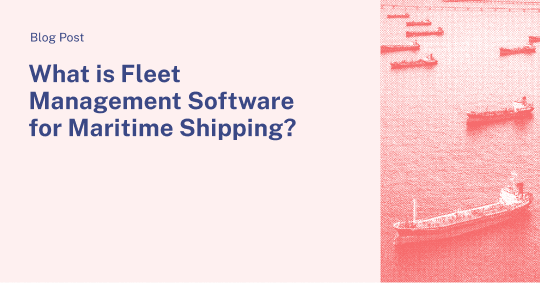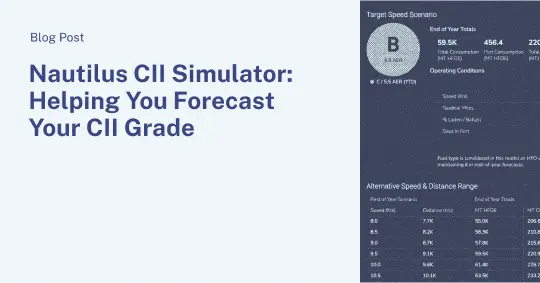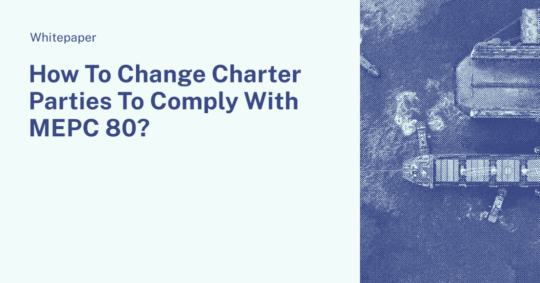Charter parties are at the heart of the shipping industry, binding counterparties into relationships around vessels. Given a history stretching back centuries, these agreements have undergone few changes over time and have become living fossils of a bygone era. That needs to change for our industry to ever achieve its decarbonization objectives – and it is a systemic transformation that will benefit everyone.
With terms written in an era that predates technology like sensors, low-earth orbit satellite, and cloud software, CP agreements are a byproduct of their time. While small incremental change has helped to update them for some modern requirements, overall they are anachronistic in an era where trusted real-time data is available at the click of a button. The enduring implications of this are deeply problematic, and nothing more so than misaligned incentive structure between owners and charterers. Owners are disincentivized from sharing any information with their charterers beyond noon reports, fearing an increased exposure for performance claims and lacking any positive incentive to improve efficiency. Meanwhile, operators are focused on maximizing profit – often demurrage – while operating within constraints that require hurry-up-to-wait behavior. These mismatched interests have impeded transparency and created a zero sum dynamic, resulting in a relationship that is optimized for contract terms of a bygone era – not for just-in-time arrival and maximum economic and environmental efficiency.
A good example of the rigidity of charter parties are the performance clauses that are agreed on at the outset of a charter period, which can be a decade or more in duration. These benchmarks fail to account for how vessel performance may evolve over time, setting unrealistic performance expectations that result in claims risk for the owners and unmet expectations for charterers. Setting a static baseline for performance, typically with also a limited scope of speed ranges, makes it nearly impossible to dynamically improve over the course of time. To stay compliant with charter party parameters, charterers may have to run voyages inefficiently, resulting in wasted fuel and excess emissions because of a lack of access to dynamic speeds. The operator incurs extra fuel and CO2 costs, while owners see their vessels’ CII scores degrade faster as a result of sub-optimal management.
In a world where alternative fuels and green corridors dominate headlines in the race to net zero, it is critical that the industry first reexamines the root cause at the heart of these baseline inefficiencies: the charter party relationship. Regulations such as CII and EEXI that target operational efficiency have underlined the need for the industry to pluck this low-hanging fruit and accelerate decarbonization efforts. And it will only be by revamping this type of daily decision-making and analysis with trusted data that our industry will be able to execute effectively in that future world – one where bunkering decisions are many times more complex, where vessels are increasingly sophisticated, and where asymmetric commercial costs from emissions require access to real-time decision support.
We can simplify this into three key priorities the industry needs to address to reach improved efficiency: a redefinition of charter parties in line with current practices and technologies, a cross-industry mindset shift, and the technology to ease the transition.
1) The industry must rethink and renovate Charter Parties.
BIMCO took a needed step in September 2022 by introducing a new CII clause that splits the responsibility for a vessel’s CII grade between the owner and the charterer, but adoption has been slow and this is only a drop in the ocean of the work that needs to be done to redefine the rules of engagement between the two. Companies have to be incentivized to share insights to improve technical and operational efficiency. Rather than working off static contracts, businesses should embrace digital terms, breaking down legacy frameworks. For example, the speed limitations of current charter parties – that force operators to make suboptimal decisions – are a perfect example of where better insight can be shared to improve outcomes for both sides. In time charters, speed and consumption warranties don’t achieve their intended effect – they act as a slow form of punishment for poor performance, but they don’t enable a proactive relationship that truly maximizes technical and operational efficiency.
2) We need to empower stakeholders from ship to shore to embrace collaboration and transparency as the default mode of engagement across the industry.
Libraries could be filled with books on organizational change management – it is a significant undertaking to shift centuries-old beliefs. When introducing new ways of working, it is important to consider the individuals who make up the organizations and devise change management programs that will enable them to successfully adapt. What we’ve found at Nautilus is that this is true across multiple vectors. Certainly the owner-operator-charterer relationship requires a new approach. Masters and chief engineers are often the decision makers that are responsible with the key operational decisions in real time. Connecting the crew with the shoreside team around information helps to build trust and accountability. And perhaps more than anything – management needs to provide clarity and incentives around what is important, by implementing KPIs and rewarding outperformance.
3) We need to capitalize on technology that already exists.
The biggest opportunity – and the reason this change needs to happen today – is that the technology is already here to support this transformation. Speed and route optimization powered by machine learning have been in the market for years. Machine learning allows us to build digital twins of vessels to determine the optimal operating parameters – today and in the future. With trusted data acting as an unbiased source of truth and insights between owners and charterers, we can adopt a consultative and dynamic approach to charter parties that result in win-win outcomes for both. And for us all, it creates the opportunity to achieve 30% emissions reductions in the next decade, while delivering bottom line value in excess of $50 billion back to the P&Ls of the companies that achieve the change.
All three key priorities have to work in tandem to get closer to net zero – and if we achieve them soon, net-zero by 2050 becomes a true possibility to our industry, where even the current International Maritime Organization objective is seen as aggressive by many. For our industry to significantly reduce emissions in line with whatever targets are ultimately set by the IMO – while also improving commercial bottom lines in an environment where the cost of fuel and consumption is sure to rise – we need to move to a new way of working. One that is inherently more collaborative, data-driven, and optimized for efficiency. Decarbonization takes a crew rowing in the same direction, no one organization can do it alone. We need to come together now – owners, charterers, managers, shipyards, technology providers, NGOs, and more – to forge this greener future. And we need to act now before it’s too late.
—
Matt Heider recently spoke at the Financial Times Commodities Global Summit 2023. Read the event recap here or submit the form below to access the full library of exclusive Financial Times Summit content and interviews, including Matt’s speeches at the event.


